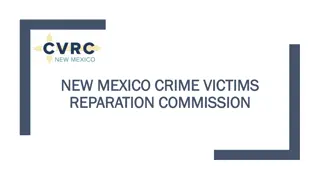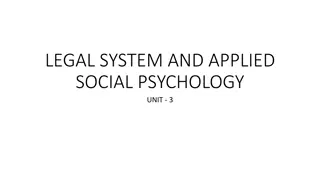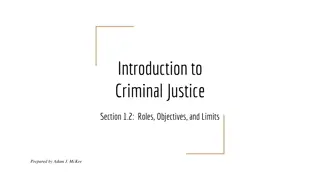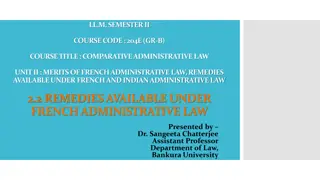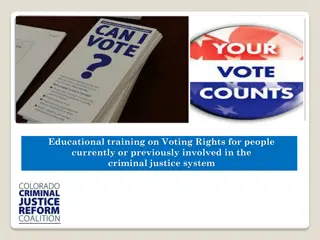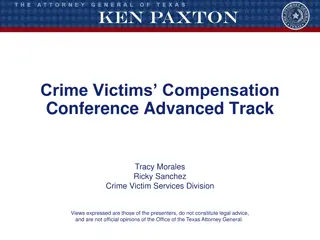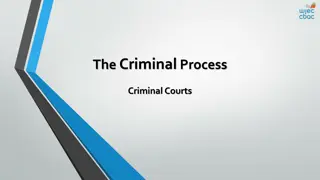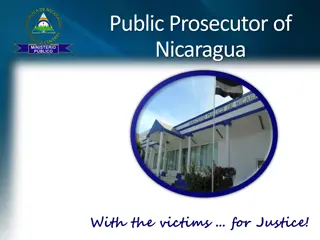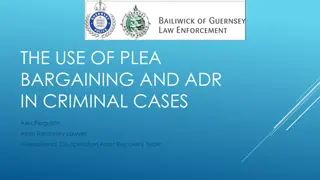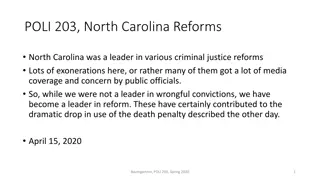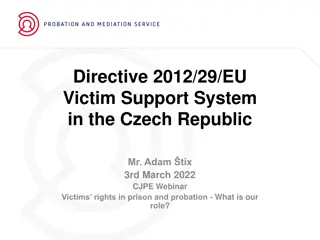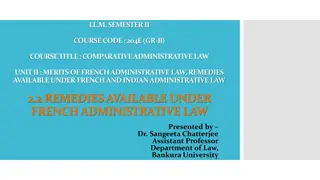Understanding Victims' Rights and Remedies in the Criminal Justice System
Explore the importance of victims' rights and remedies in the criminal justice system, including state-specific information, strategies to support victims, and the processes involved in enforcing laws, prosecuting offenders, and determining punishments for crimes such as misdemeanors. Gain insights into the roles of victim services personnel in informing and assisting victims throughout the legal proceedings.
Uploaded on Sep 15, 2024 | 0 Views
Download Presentation

Please find below an Image/Link to download the presentation.
The content on the website is provided AS IS for your information and personal use only. It may not be sold, licensed, or shared on other websites without obtaining consent from the author. Download presentation by click this link. If you encounter any issues during the download, it is possible that the publisher has removed the file from their server.
E N D
Presentation Transcript
Learning Objectives 1 Identify state-specific victims rights. 2 Identify criminal justice system remedies that may benefit victims. Identify strategies to support victims while they participate in criminal justice system processes. 3
All 50 states; Washington, DC; and the federal government have victims rights established through constitutional amendments, statutes, and/or rules. Victims Rights It is imperative that victim services personnel understand victims rights, inform victims of their rights (at the earliest opportunity and ongoing), and support victims in exercising their rights.
Victims Rights in [State] [Victim Right] [Victim Right] [Victim Right] [enter state- specific information] [enter state- specific information] [enter state- specific information]
Criminal Justice System The system of enforcing laws that is directly involved in apprehending, prosecuting, defending, sentencing, and punishing those who are suspected or convicted of criminal offences
Criminal Justice System Infractions What are possible consequences for offenders? What actions are required by victims? Which court?
Infractions and Punishments [Crime] [enter punishment range] [Crime] [enter punishment range] [Crime] [enter punishment range] [Crime] [enter punishment range] [Crime] [enter punishment range]
Criminal Justice System Misdemeanors What are possible consequences for offenders? What actions are required by victims? Which court?
Class A Misdemeanors and Punishments [Crime] [enter punishment range] [Crime] [enter punishment range] [Crime] [enter punishment range] [Crime] [enter punishment range] [Crime] [enter punishment range]
Class B Misdemeanors and Punishments [Crime] [enter punishment range] [Crime] [enter punishment range] [Crime] [enter punishment range] [Crime] [enter punishment range] [Crime] [enter punishment range]
Class C Misdemeanors and Punishments [Crime] [enter punishment range] [Crime] [enter punishment range] [Crime] [enter punishment range] [Crime] [enter punishment range] [Crime] [enter punishment range]
Criminal Justice System Felonies What are possible consequences for offenders? What actions are required by victims? Which court?
First-Degree Felonies and Punishments [Crime] [enter punishment range] [Crime] [enter punishment range] [Crime] [enter punishment range] [Crime] [enter punishment range] [Crime] [enter punishment range]
Second-Degree Felonies and Punishments [Crime] [enter punishment range] [Crime] [enter punishment range] [Crime] [enter punishment range] [Crime] [enter punishment range] [Crime] [enter punishment range]
Third-Degree Felonies and Punishments [Crime] [enter punishment range] [Crime] [enter punishment range] [Crime] [enter punishment range] [Crime] [enter punishment range] [Crime] [enter punishment range]
Key Actors Victims Rights Attorney Law Defense Attorney Prosecutor Victim Defendant Enforcement Public defender or private criminal defense attorney Represents the victim (when retained by the victim) Represents jurisdiction (state & federal) The victim is generally a witness in the case. Investigates reported crimes Person accused of a crime Represents the accused
Investigation Process Investigation of criminal allegations by law enforcement Probable cause established Case Closed *options in bold indicate movement to next step in process
Investigation Process Actions Related to Suspects Prosecutor Communication Arrest *options in bold indicate movement to next step in process
Investigation Process Prosecution Decision Warrant or Case Furthered Case Declined *options in bold indicate movement to next step in process
Bond Types Deposited with Clerk of Court Used to pay all/portion of fine Returned upon dismissal/acquittal Cash No deposit required Promise to pay fee for failure to appear Judicial Public Company signs on behalf of defendant Percentage of bond charged as fee for service Professional Surety Property used as surety Property value must equal or exceed bond Property
Grand Jury A group of people summoned to determine whether the facts and accusations presented by the prosecutor warrant an indictment and eventual trial of the accused Grand Jury -Selection of jurors -Public access -Victim testimony -Indictment decision Grand Jury Process
Court Hearings and Court Structure Pretrial Hearings Court Structure [hearing type and purpose] [hearing type and purpose] [hearing type and purpose] Trial court where cases begin Appellate court where appeals are first heard Supreme Court further appeals, final authority in cases
Possible Outcomes Negotiated agreement Judge retains authority to accept/reject Plea Agreement Bench trial Jury trial Trial Probation Incarceration Sentencing Alternative Resolutions Diversion
Victim Role in Possible Outcomes Plea Agreement Discussion with prosecutor Provide testimony Ongoing communication with prosecutors Trial Sentencing Provide Victim Impact Statement Alternative Resolution Discussion with prosecutor
Victim Services Role Provide information about the criminal justice system Review victims rights with victims and system professionals Advocate for responses and processes that align with victims rights and expressed needs of victims Act as a liaison between victim and system professionals
Victim Services Role, continued Provide meeting and court accompaniment Review confidentiality/privilege rights and limitations Provide referralinformation for resources, including victims rights attorneys Clarify your role you are not an attorney and cannot provide legal advice
Documentation and Subpoenas Victim services documentation should reflect full, clear, and accurate record of activity performed. Documentation may lead to subpoenas as a witness. The credibility of victim services is reinforced.
There may also be remedies victims can pursue through the civil justice system. Civil Justice System Victims should be referred to attorneys or legal aid programs to learn more about their options.
Questions [enter contact information for trainers]




